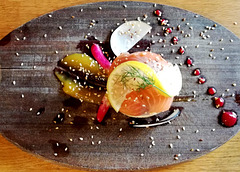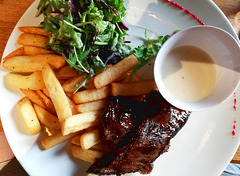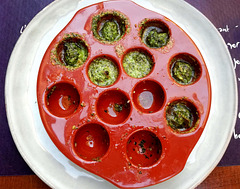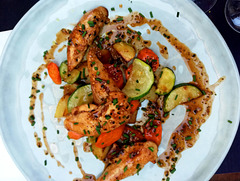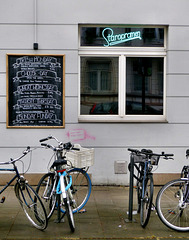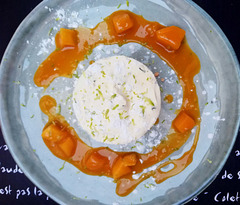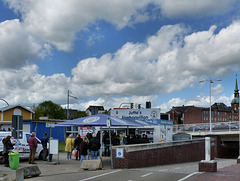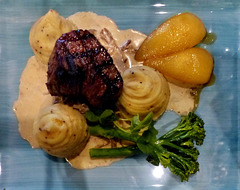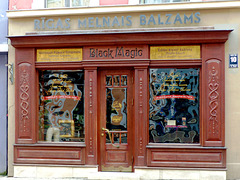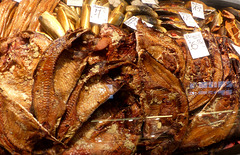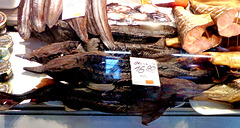
miam-miam
Restaurants, eateries, coffee-shops, take-aways, food and drinks!
Lyon - Midi Minuit Confluence
| |
|
|
|
Many years ago, I spent a couple of weeks in Lyon, trying to learn French with the support of a French Language School (Lyon Bleu). It was a pretty mediocre success, but I liked Lyon so much, that since then I do return, just to stroll the streets, watch the Rhone - and have a great dinner.
The "Midi Minuit Confluence" is a kind of very stylish brasserie. For me, it was a little "over styled". I di prefer proper "normal" restaurants ("bouchons") with a reliable quality. So I was a little in doubt, but - surpise - the food was really astonishing good. It was excellent, to be honest!
DÔME DE SAUMON ET SA BROUSSE DE CHÈVRE
Lyon - Midi Minuit Confluence
| |
|
|
|
Many years ago, I spent a couple of weeks in Lyon, trying to learn French with the support of a French Language School (Lyon Bleu). It was a pretty mediocre success, but I liked Lyon so much, that since then I do return, just to stroll the streets, watch the Rhone - and have a great dinner.
The "Midi Minuit Confluence" is a kind of very stylish brasserie. For me, it was a little "over styled". I di prefer proper "normal" restaurants ("bouchons") with a reliable quality. So I was a little in doubt, but - surpise - the food was really astonishing good. It was excellent, to be honest!
OEUFS FRIANDS, SAUCE ASIATIQUE
Breaded poached eggs served with Asian sauce
Lyon - Midi Minuit Confluence
| |
|
|
Many years ago, I spent a couple of weeks in Lyon, trying to learn French with the support of a French Language School (Lyon Bleu). It was a pretty mediocre success, but I liked Lyon so much, that since then I do return, just to stroll the streets, watch the Rhone - and have a great dinner.
The "Midi Minuit Confluence" is a kind of very stylish brasserie. For me, it was a little "over styled". I di prefer proper "normal" restaurants ("bouchons") with a reliable quality. So I was a little in doubt, but - surpise - the food was really astonishing good. It was excellent, to be honest!
FAUX FILET GRILLÉ
Faux flet, smoked over beech wood, marinated in pesto, with fries and blue cheese sauce
Tournus - La Bohème
| |
|
|
Tournus is famous for the church of St Philibert built in the early 11th century. It is the main surviving building of abbey, founded in the 6th century and refounded after it had been raided by the Maurs, by a group of homeless monks from Normoutier as their monastery had been destroyed by the Normans. The monks carried the relics of St. Philibert with them - and built the church. I have uploaded already many photos taken here over the years.
On the other side, the small town Tournus (pop. ~ 5500) is famous for - "haute cuisine" - restaurants. I do not think there is another town in France that has that many Michelin stars. In and around Tournus are more than half a dozend of restaurants from eone to three or four stars. I have been in two - "one star"-restaurants. Fantastic.
This time, we arrived late, had not booked a table in advance - and so chose a small restaurant without any micheline star.
"La Boheme" is a nice restaurant. It serves the local people with great food to very agreeable prices.
Tournus - La Bohème
| |
|
|
Tournus is famous for the church of St Philibert built in the early 11th century. It is the main surviving building of abbey, founded in the 6th century and refounded after it had been raided by the Maurs, by a group of homeless monks from Normoutier as their monastery had been destroyed by the Normans. The monks carried the relics of St. Philibert with them - and built the church. I have uploaded already many photos taken here over the years.
On the other side, the small town Tournus (pop. ~ 5500) is famous for - "haute cuisine" - restaurants. I do not think there is another town in France that has that many Michelin stars. In and around Tournus are more than half a dozend of restaurants from eone to three or four stars. I have been in two - "one star"-restaurants. Fantastic.
This time, we arrived late, had not booked a table in advance - and so chose a small restaurant without any micheline star.
"La Boheme" is a nice restaurant. It serves the local people with great food to very agreeable prices.
Escargots de Bourgogne, beurre persillé
Burgundy snails with parsley butter
Tournus - La Bohème
| |
|
|
Tournus is famous for the church of St Philibert built in the early 11th century. It is the main surviving building of abbey, founded in the 6th century and refounded after it had been raided by the Maurs, by a group of homeless monks from Normoutier as their monastery had been destroyed by the Normans. The monks carried the relics of St. Philibert with them - and built the church. I have uploaded already many photos taken here over the years.
On the other side, the small town Tournus (pop. ~ 5500) is famous for - "haute cuisine" - restaurants. I do not think there is another town in France that has that many Michelin stars. In and around Tournus are more than half a dozend of restaurants from eone to three or four stars. I have been in two - "one star"-restaurants. Fantastic.
This time, we arrived late, had not booked a table in advance - and so chose a small restaurant without any micheline star.
"La Boheme" is a nice restaurant. It serves the local people with great food to very agreeable prices.
Aiguillettes de poulet jaune panée aux graines
Chicken breaded with seed
Tournus - La Bohème
| |
|
|
Tournus is famous for the church of St Philibert built in the early 11th century. It is the main surviving building of abbey, founded in the 6th century and refounded after it had been raided by the Maurs, by a group of homeless monks from Normoutier as their monastery had been destroyed by the Normans. The monks carried the relics of St. Philibert with them - and built the church. I have uploaded already many photos taken here over the years.
On the other side, the small town Tournus (pop. ~ 5500) is famous for - "haute cuisine" - restaurants. I do not think there is another town in France that has that many Michelin stars. In and around Tournus are more than half a dozend of restaurants from eone to three or four stars. I have been in two - "one star"-restaurants. Fantastic.
This time, we arrived late, had not booked a table in advance - and so chose a small restaurant without any micheline star.
"La Boheme" is a nice restaurant. It serves the local people with great food to very agreeable prices.
Médaillon de veaux aux echalions confits
Cologne - James Joyce
| |
|
|
Cologne is the fourth-largest city in Germany - and one of the oldest. A Germanic tribe, the Ubii, had a settlement here, this was named by the Romans "Oppidum Ubiorum". In 50 AD, the Romans founded "Colonia Claudia Ara Agrippinensium", the city then became the provincial capital of "Germania Inferior".
In the before-corona-times the James Joyce has been a nice place to have a nice Guinness, sit outside and watch "the wheels go round and round I really love to watch them roll" (John Lennon). This was especially easy, as the pub is located at a roundabout. Now it is closed and only the Staropramen sign flickers. Czech beer in an Irish pub.
Tournus - La Bohème
| |
|
|
|
Tournus is famous for the church of St Philibert built in the early 11th century. It is the main surviving building of abbey, founded in the 6th century and refounded after it had been raided by the Maurs, by a group of homeless monks from Normoutier as their monastery had been destroyed by the Normans. The monks carried the relics of St. Philibert with them - and built the church. I have uploaded already many photos taken here over the years.
On the other side, the small town Tournus (pop. ~ 5500) is famous for - "haute cuisine" - restaurants. I do not think there is another town in France that has that many Michelin stars. In and around Tournus are more than half a dozend of restaurants from eone to three or four stars. I have been in two - "one star"-restaurants. Fantastic.
This time, we arrived late, had not booked a table in advance - and so chose a small restaurant without any micheline star.
"La Boheme" is a nice restaurant. It serves the local people with great food to very agreeable prices.
Tarte tatin aux pommes et aux abricots
Kappeln - Jutta´s Fischpavillon
| |
|
Kappeln certainly has a lot to offer. One of the biggest attractions is "Jutta's Fischpavillion" located next to the drawbridge. Foodies queue up there because here you can get the very best fried herrings of Schleswig Holstein or even Northern Germany. These herrings are worth a detour.
Arcambal - Les Rives d'Olt
| |
|
|
The "Chambres et table d'hôtes" is actually located in Béars (near Vers) and is not easy to find (without GPS), but it is worth any detour. This is a perfect place to explore the region. Evelyne and Phillip are lovely hosts, who share their knowledge (and wisdom!) with their guests.
It is great to have dinner in the evening together with the hosts and the other guests. Evelyne is a really great chef, so you are able to taste a cuisine with local flavours. Over the years we had talked about the different cassoulets - and she had offered to prepare one "next time".
In summer 2021 Evelyne prepared this cassoulet for the guests.
Merci beaucoup!
www.lesrivesdolt.com/
Vichy - La Table Les Nations
| |
|
|
The place was founded by the Romans at springs already used by them.
In 1344, Duke Pierre I de Bourbon obtained the possession of the lands. In 1410, a monastery of the Benedictines was founded here. In 1527, the Bourbon possessions reverted to the French crown. At the end of the 16th century, the first patients came to Vichy for the healing springs, which were soon considered to be true "miracle springs".
The springs of Vichy became famous thanks to the Marquise de Sevigné, who came here for a cure in 1676 and 1677. She praised its healing properties. In 1761, two daughters of Louis XV came here for a cure. Their nephew, Louis XVI, had a new bath complex built at the springs in 1787. Napoleon's mother stayed here for a cure in 1799. It is attributed to her influence that the emperor had the "Parc de Sources" laid out in 1812. In 1830, the spa house was inaugurated. Napoleon III made Vichy his summer residence for several years. The town became a fashionable spa for the international aristocracy.
From 1899 to 1903 following the construction of the Centre Thermal of the Dome with the drinking hall, a 700-meter-long ambulatory and a bath in oriental style were erected. Around 1900, 40,000 spa guests per year came to Vichy, and shortly before World War I, the number was nearly 100,000.
During World War II, the town became the headquarters of the French Vichy regime under Philippe Pétain.
After the war, Vichy resumed spa operations and once again acquired the title of "Reine des villes d'eaux" ("Queen of Spas"). But that changed in the 1970s, when the celebrities among the bathers preferred other resorts.
Together with ten other spas of Europe the "Great Spas of Europe", Vichy was included in the UNESCO World Heritage List in 2021.
The elegant "La Table Les Nations" is the restaurant of the "Hotel Les Nations".
Gdansk - Winne Grono
| |
|
Winne Grono, the name of the restaurant, translates to "wine grape".
The restaurant is located in a wonderful old building, so not only the environment is superb, the food is it as well.
Zander fillet, small pumpkin dumplings, marinated pea mousse
Gdansk - Winne Grono
| |
|
|
Winne Grono, the name of the restaurant, translates to "wine grape".The restaurant is located in a wonderful old building, so not only the environment is superb, the food is it as well.
Beefsteak, potato and white mustard puree, mushrooms, broccoli and marinated pears
Gdansk - Winne Grono
| |
|
Winne Grono, the name of the restaurant, translates to "wine grape".The restaurant is located in a wonderful old building, so not only the environment is superb, the food is it as well.
Saltibarsciai, a Lithuanian cold beet soup served with hot potatoes.
Riga - Rīgas Melnais balzams
| |
|
Riga is the capital of Latvia. With a population of more than 600.000 about a third of all Latvians live here. A settlement of the Finno-Ugric Livs existed on the bank of the Düna. At the end of the 12th century, merchants from Gotland came to trade here.
Albert von Buxthoeven, a fierce missionary, was the first bishop in Riga from 1201 to 1229. Riga developed as the hub of Russian trade and the starting point of the German colonization of the Baltic.
The merchants who settled here after the subjugation of the surrounding peoples rapidly gained influence. In 1225, they were able to elect the city bailiff themselves, when the City Council existed already.
After the Reformation, the power of the archbishops came to an end. After the outbreak of the Livonian War in 1558 the city favoured the status of a free imperial city of the Holy Roman Empire. It was only when the imperial support failed to materialize that the renewed advance of Russian armies led the city to pay homage to Poland's King Stephen Báthory in 1581, who in return confirmed the city's traditional freedoms and privileges.
The 40-year Polish-Lithuanian rule, under which the citizens of Riga successfully resisted anti-Reformation efforts ended with the conquest of the city by Gustav II Adolf of Sweden in 1621. The Swedish crown treated Riga by its rank as the second-largest city in the kingdom and had it lavishly fortified. During the Russo-Swedish War (1656-1658), Riga withstood the Russian siege and maintained its position as one of the most important cities in Sweden until the beginning of the 18th century. During this period the city enjoyed extensive self-government.
Rīgas Melnais balzams (Riga Black Balsam) is a traditional Latvian liqueur made from herbs, flowers, oils and berries with 45% alcohol content.
The traditional recipe was created in 1752 by Abraham Kunze, an apothecary living in Riga. It was initially known as the Kunzer Balsam and sold only in apothecaries as a prescription medicine.
According to a legend, Empress Catherine the Great was heading back to Russia and stopped in Riga for a few days. She became very ill and Kunze was asked to step in after the empress's personal doctor proved helpless. The balsam's success in curing Catherine the Great provided it with popularity and Kunze with exclusive rights to produce the balsam for the next 50 years.
Riga - Rīgas Centrāltirgus
| |
|
Riga is the capital of Latvia. With a population of more than 600.000 about a third of all Latvians live here. A settlement of the Finno-Ugric Livs existed on the bank of the Düna. At the end of the 12th century, merchants from Gotland came to trade here.
Albert von Buxthoeven, a fierce missionary, was the first bishop in Riga from 1201 to 1229. Riga developed as the hub of Russian trade and the starting point of the German colonization of the Baltic.
The merchants who settled here after the subjugation of the surrounding peoples rapidly gained influence. In 1225, they were able to elect the city bailiff themselves, when the City Council existed already.
After the Reformation, the power of the archbishops came to an end. After the outbreak of the Livonian War in 1558 the city favoured the status of a free imperial city of the Holy Roman Empire. It was only when the imperial support failed to materialize that the renewed advance of Russian armies led the city to pay homage to Poland's King Stephen Báthory in 1581, who in return confirmed the city's traditional freedoms and privileges.
The 40-year Polish-Lithuanian rule, under which the citizens of Riga successfully resisted anti-Reformation efforts ended with the conquest of the city by Gustav II Adolf of Sweden in 1621. The Swedish crown treated Riga by its rank as the second-largest city in the kingdom and had it lavishly fortified. During the Russo-Swedish War (1656-1658), Riga withstood the Russian siege and maintained its position as one of the most important cities in Sweden until the beginning of the 18th century. During this period the city enjoyed extensive self-government.
Rīgas Centrāltirgus (Riga Central Market) is Europe's largest market in Riga. It was inscribed on the UNESCO World Heritage List in 1998 together with the Old Town of Riga. It was planned in 1922 and built between 1924 and 1930. The main structures of the market are pavilions, built by reusing the metal frameworks of old WWI German Zeppelin hangars.
The market covers an area of 72,300 square metres and has about 3,000 trade stalls.
Smoked fish
Riga - Rīgas Centrāltirgus
| |
|
|
Riga is the capital of Latvia. With a population of more than 600.000 about a third of all Latvians live here. A settlement of the Finno-Ugric Livs existed on the bank of the Düna. At the end of the 12th century, merchants from Gotland came to trade here.
Albert von Buxthoeven, a fierce missionary, was the first bishop in Riga from 1201 to 1229. Riga developed as the hub of Russian trade and the starting point of the German colonization of the Baltic.
The merchants who settled here after the subjugation of the surrounding peoples rapidly gained influence. In 1225, they were able to elect the city bailiff themselves, when the City Council existed already.
After the Reformation, the power of the archbishops came to an end. After the outbreak of the Livonian War in 1558 the city favoured the status of a free imperial city of the Holy Roman Empire. It was only when the imperial support failed to materialize that the renewed advance of Russian armies led the city to pay homage to Poland's King Stephen Báthory in 1581, who in return confirmed the city's traditional freedoms and privileges.
The 40-year Polish-Lithuanian rule, under which the citizens of Riga successfully resisted anti-Reformation efforts ended with the conquest of the city by Gustav II Adolf of Sweden in 1621. The Swedish crown treated Riga by its rank as the second-largest city in the kingdom and had it lavishly fortified. During the Russo-Swedish War (1656-1658), Riga withstood the Russian siege and maintained its position as one of the most important cities in Sweden until the beginning of the 18th century. During this period the city enjoyed extensive self-government.
Rīgas Centrāltirgus (Riga Central Market) is Europe's largest market in Riga. It was inscribed on the UNESCO World Heritage List in 1998 together with the Old Town of Riga. It was planned in 1922 and built between 1924 and 1930. The main structures of the market are pavilions, built by reusing the metal frameworks of old WWI German Zeppelin hangars.
The market covers an area of 72,300 square metres and has about 3,000 trade stalls.
Sturgeon
Jump to top
RSS feed- Latest items - Subscribe to the latest items added to this album
- ipernity © 2007-2024
- Help & Contact
|
Club news
|
About ipernity
|
History |
ipernity Club & Prices |
Guide of good conduct
Donate | Group guidelines | Privacy policy | Terms of use | Statutes | In memoria -
Facebook
Twitter

